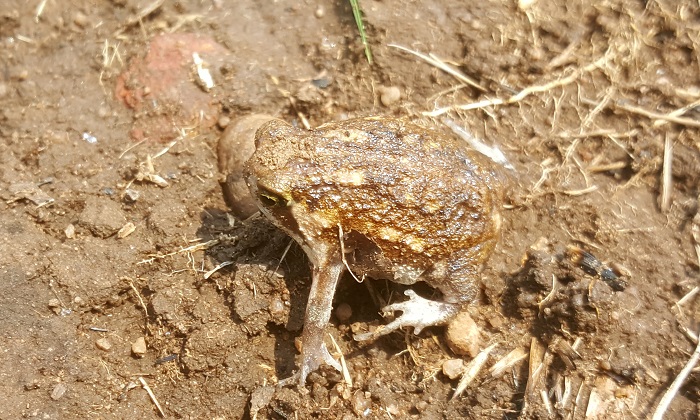Cover photo by Garth Aiston.
Find the Bilbo’s Rain Frog in the FBIS database (Freshwater Biodiversity Information System) here.
Family Brevicepitidae
Identification
Bilbo’s Rain Frog is a relatively small species: males are 20–25.9 mm (N = 19) in body length, and the single paratype female measured 28.7 mm. The call is a sharp, high-pitched trill of moderate length (emphasized frequency 2540–3042 Hz; duration 103–388 ms; N = 15). Each bout of calling consists of 7–19 closely spaced calls (Minter 2003).
The call of B. bagginsi is easily distinguished from the long, high-pitched whistle of B. sopranus, the very short, high-pitched chirp of B. mossambicus and the lower-pitched calls of B. adspersus, which tend to be emitted in groups within the call bout (Minter 1995, 1997, 2003).
B. verrucosus, which also occurs in the Boston area, is larger than B. bagginsi and has a granular skin with two or more longitudinal, glandular ridges on the dorsum. The call of B. verrucosus is lower in pitch and longer than that of B. bagginsi (emphasized frequency 1550–2238 Hz; duration 421–912 ms; n = 34; Minter 2003).
Other Breviceps species that may occur in sympatry with B. bagginsi are B. sopranus, B. adspersus and B. mossambicus. Colour and markings are highly variable in these species and cannot be used to distinguish them from one another or from B. bagginsi. Identification should be based on their characteristic advertisement calls.
Habitat
Bilbo’s Rain Frog inhabits the grassy verges of roads in heavily afforested areas at altitudes of 900–1400 m. The vegetation at these localities, prior to afforestation, probably comprised Short Mistbelt Grassland or Moist Upland Grassland. At present, no populations are known from undisturbed habitats.
Behaviour
Very little is known about the life history of Bilbo’s Rain Frog. Breeding occurs in spring and early summer. Males call from the surface or from shallow depressions concealed beneath vegetation. In wet weather, calling continues throughout the day, and males will continue to call from well-concealed sites in full sunlight at ambient temperatures as high as 28°C. Amplexus and oviposition have not been observed.
During the emergence of termite alates, individuals leave their places of concealment to feed in the open.
Status and Conservation
Status
Bilbo’s Rain Frog is a recently described species (Minter 2003). It is assigned to the Data Deficient category (this publication). Until recently, this species was not known to occur in any protected area; however, a population has recently been discovered in grassland at Mkambati Nature Reserve, Eastern Cape.
Threats
Habitat loss due to afforestation obviously represents a serious threat to this species as it is known only from narrow, grassy roadside verges in areas where natural grassland has been replaced by plantations of eucalypts and pines. The fire regimes to which these grassy strips are subjected, as part of the management of the plantations, may, in the medium to long term, affect the viability of these frog populations. Road kills also constitute a serious threat, as all the known breeding sites lie alongside roads. The frogs cross the roads during the breeding season and are especially vulnerable when they swarm onto roads during the emergence of termite alates.
Recommended conservation actions
Distribution, life history and ecological data are urgently needed to assess the conservation status of B. bagginsi and develop an appropriate conservation plan.
Distribution
During the atlas period, Bilbo’s Rain Frog was recorded from only five quarter-degree grid cells: three between Babanango, Melmoth, and Ulundi (2831AD, CA, CB), one between Boston and Howick (2930CA), and one from the greater Durban area. Since then, another population has been found in the Eastern Cape at Mkambati Nature Reserve (not shown on the map). The atlas data are accurate but incomplete. A more intensive survey of suitable habitats may reveal additional populations.

Further Resources
The use of photographs by Garth Aiston is acknowledged.
Bilbo’s Rain Frog Breviceps bagginsi Minter, 2003
Other Common Names: Bilbo se Blaasoppadda (Afrikaans)
Recommended citation format: Minter, LR; Tippett, RM. (2025). Bilbo’s Rain Frog Breviceps bagginsi. Biodiversity and Development Institute, Cape Town. Available online at https://thebdi.org/2022/01/11/bilbos-rain-frog-breviceps-bagginsi/
This species text has been updated and expanded from the text in the
2004 frog atlas: Minter, LR. (2004). Bilbo’s Rain Frog Breviceps bagginsi. In Minter LR et al 2004.
References:
Minter, LR; Burger, M; Harrison, JA; Braack, HH; Bishop, PJ; Kloepfer, D. (Editors). (2004). Atlas and Red Data Book of the Frogs of South Africa, Lesotho and Swaziland. Smithsonian Institution, Washington, and Avian Demography
Unit, Cape Town.
Carruthers, V; du Preez, L. (2017). Frogs of southern Africa: A Complete Guide. Struik Nature, Cape Town.
Channing, A. (2001) Amphibians of Central and Southern Africa. Protea Book House, Pretoria
Claus, B; Claus, R. (2002). Common Amphibians and Reptiles of Botswana. Gamsberg Macmillan, Windhoek.

